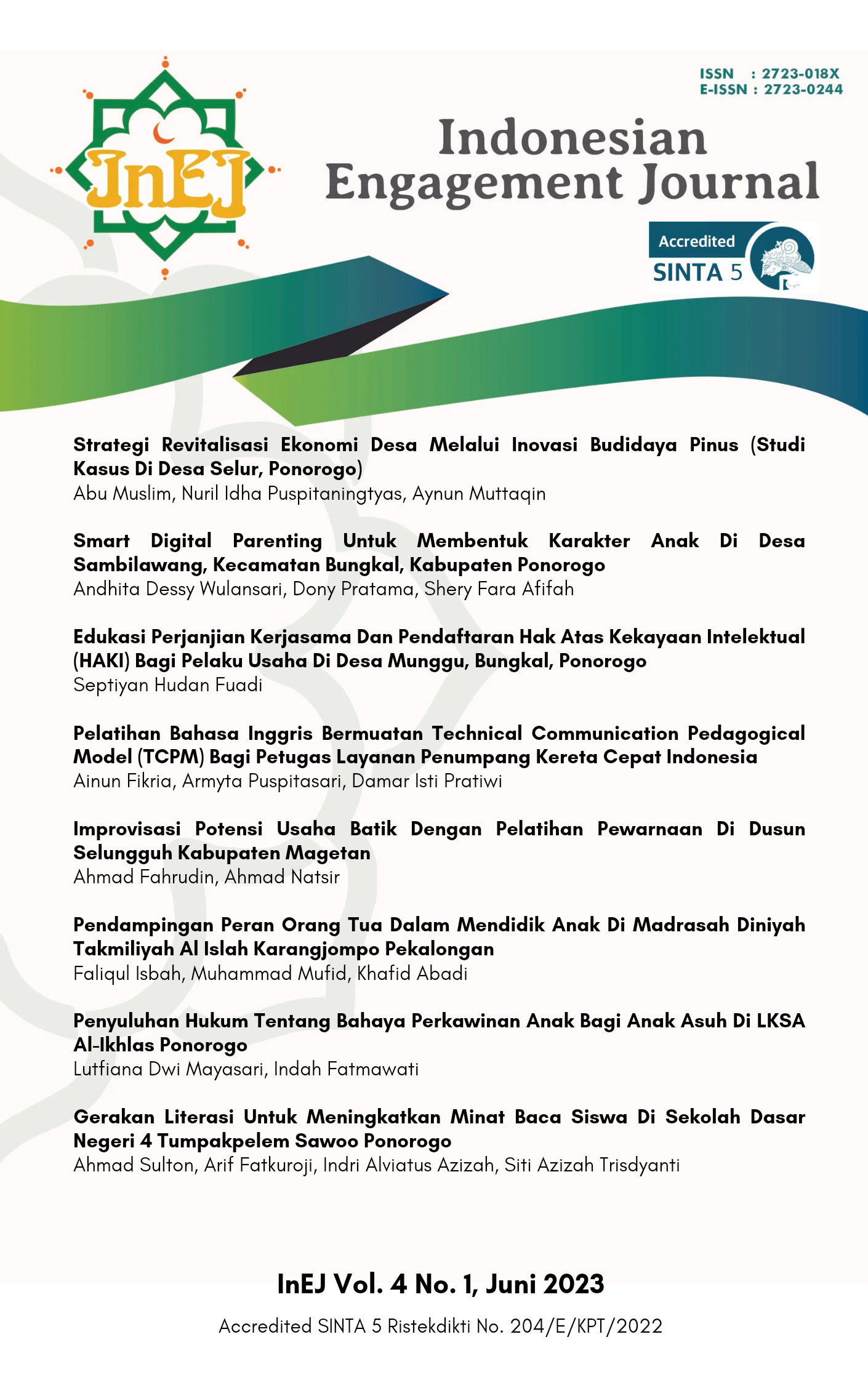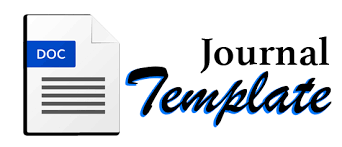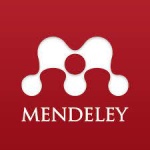REVITALISASI FUNGSI MASJID SEBAGAI PUSAT PEMBERDAYAAN MANAJEMEN PENDIDIKAN EKONOMI KREATIF DI TENGAH KOMPLEKSITAS PROBLEM PLURALISME KOMUNITAS MUSLIM MARJINAL DI DESA KLEPU KECAMATAN SOOKO KABUPATEN PONOROGO
DOI:
https://doi.org/10.21154/inej.v4i1.7252Keywords:
Revitalization, Mosques, Empowerment of the creative economyAbstract
Artikel ini membahas tingginya tingkat kristenisasi di Indonesia, dengan fokus pada dampak ekonomi dan pangan sebagai celah untuk program pemurtadan. Desa Klepu, Kecamatan Sooko, Kabupaten Ponorogo, Jawa Timur, menjadi studi kasus karena kondisi geografisnya yang kering dan sering mengalami kekeringan serta krisis pangan. Kemiskinan di kalangan mayoritas penduduk Muslim di desa ini menjadi pemicu utama penyebaran kristenisasi. Artikel menyoroti masjid sebagai tempat strategis untuk pemberdayaan ekonomi masyarakat, bukan hanya sebagai tempat ibadah, tetapi juga pusat kegiatan, termasuk dalam bidang ekonomi kreatif. Pendekatan yang digunakan adalah action research melalui metode Participatory Rapid Appraisal (PRA) dengan prinsip emancipatory, yang melibatkan pengorganisasan masyarakat melalui pendidikan orang dewasa (andragogi). Kegiatan pemberdayaan melibatkan pembentukan kelompok wirausaha yang disesuaikan dengan struktur kelompok majlis ta'lim yang sudah ada. Keberhasilan program revitalisasi fungsi masjid sebagai pusat pemberdayaan ekonomi kreatif di Desa Klepu diakui bergantung pada sikap keterbukaan terhadap orang lain, dukungan, dan partisipasi dari semua stakeholder. Faktor penghambat mencakup sikap tradisional masyarakat dan kesulitan mencari waktu yang sesuai untuk berkumpul, mengingat sebagian besar jama'ah juga berkegiatan di ladang pertanian pada siang hari.References
Afandi, Agus et.al. Modul Participatory Action Reseacrh (PAR). (Surabaya: Lembaga Pengabdian Masyarakat (LPM) IAIN Sunan Ampel Surabaya, 2013).
Aliba’ul Chusna and Amin Wahyudi, “Revitalisasi Fungsi Masjid Sebagai Pusat Pemberdayaan Ekonomi Kreatif Bagi Komunitas Muslim Marjinal Di Desa Klepu Kecamatan Sooko Kabupaten Ponorogo,” El-Wasathiya: Jurnal Studi Agama 5, no. 1 (2017).
Chusna and Wahyudi, “Revitalisasi Fungsi Masjid Sebagai Pusat Pemberdayaan Ekonomi Kreatif Bagi Komunitas Muslim Marjinal Di Desa Klepu Kecamatan Sooko Kabupaten Ponorogo.” 2017.Fery Diantoro, “Realisasi Program Jimpitan Karang Taruna Bugis Generation Dalam Meningkatkan Peran Sosial” 1, no. 2 (2020). 162.
Jim Ife, Community Development: Creating Community Alternatives, Vision Analysis and Practice, (Australia : Longman, 1995), 56.
Mc Taggart, R. “Races of Participatory Action Research: Reciprocity among educators”. Educational Action Research Journal. Vol. 5,No. 1, 1997.
Rappaport, J., Studies in Empowerment: Introduction to the Issue, (Prevention In Human Issue, USA, 1984), 3.
Swift C. & G. Levin, Empowerment : An Emerging Mental Health Technology, (Journal of Primary Prevention, USA, 1987), xiii.
Todaro, M. P. Pembangunan Ekonomi Di Dunia Ketiga, : Edisi VI (Jakarta : Erlangga, Jakarta,1999).
Umar Faruq. “Pendampingan Transformasi Metode Pemasaran Umkm Desa Crabak Dari Tradisional Ke Digital” Crabak Dari, Tradisional Ke, And Iain Ponorogo, 3, no. 2 (2022): 1”“23.
Downloads
Additional Files
Published
Issue
Section
License
Please find the rights and licenses in InEJ. By submitting the article/manuscript of the article, the author(s) agree with this policy. No specific document sign-off is required.1. License
The non-commercial use of the article will be governed by the Creative Commons Attribution license as currently displayed on Creative Commons Attribution-NonCommercial-ShareAlike 4.0 International License.
2. Author(s)' Warranties
The author warrants that the article is original, written by stated author(s), has not been published before, contains no unlawful statements, does not infringe the rights of others, is subject to copyright that is vested exclusively in the author and free of any third party rights, and that any necessary written permissions to quote from other sources have been obtained by the author(s).
3. User/Public Rights
The spirit of InEJ is to disseminate articles published are as free as possible. Under the Creative Commons license, InEJ permits users to copy, distribute, display, and perform the work for non-commercial purposes only. Users will also need to attribute authors and InEJ on distributing works in the journal and other media of publications. Unless otherwise stated, the authors are public entities as soon as their articles got published.
4. Rights of Authors
Authors retain all their rights to the published works, such as (but not limited to) the following rights;
Copyright and other proprietary rights relating to the article, such as patent rights,
The right to use the substance of the article in own future works, including lectures and books,
The right to reproduce the article for own purposes,
The right to self-archive the article,
The right to enter into separate, additional contractual arrangements for the non-exclusive distribution of the article's published version (e.g., post it to an institutional repository or publish it in a book), with an acknowledgment of its initial publication in this journal (InEJ: Indonesian Engagement Journal).
5. Co-Authorship
If the article was jointly prepared by more than one author, any authors submitting the manuscript warrants that he/she has been authorized by all co-authors to be agreed on this copyright and license notice (agreement) on their behalf, and agrees to inform his/her co-authors of the terms of this policy. InEJ will not be held liable for anything that may arise due to the author(s) internal dispute. InEJ will only communicate with the corresponding author.
6. Royalties
Being an open accessed journal and disseminating articles for free under the Creative Commons license term mentioned, author(s) aware that InEJ entitles the author(s) to no royalties or other fees.
7. Miscellaneous
InEJ will publish the article (or have it published) in the journal if the article’s editorial process is successfully completed. The editors of Journal may modify the article to a style of punctuation, spelling, capitalization, referencing and usage that deems appropriate. The author acknowledges that the article may be published so that it will be publicly accessible and such access will be free of charge for the readers as mentioned in point 3.




